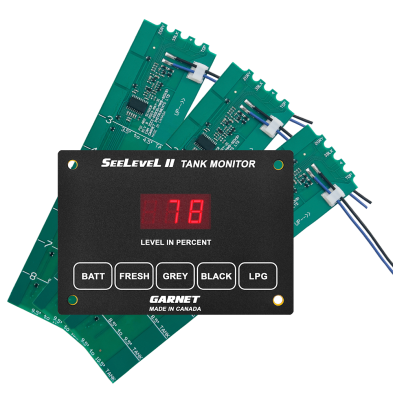Let’s be honest, having a microwave in your camper is an absolute game-changer for modern RV living. It brings a level of speed and convenience that’s hard to beat, whether you’re reheating last night’s campfire chili, defrosting a meal, or just making a quick snack. It’s that little slice of home that makes life on the road so much easier, especially on long haul days or when the weather turns sour.
Unlike fiddling with a propane stove, a microwave is fast, efficient, and saves you from burning through your precious propane supply.
Quick links: Shop RV microwaves · RV convection microwaves · Built-in trim kits · Pure sine wave inverters
Why a Microwave Is a Game-Changer on the Road

Adding or upgrading the microwave in your camper is one of the most impactful changes you can make to your daily routine. Sure, cooking over an open fire has a certain romance to it, but the reality of RV life often calls for simplicity. A microwave turns what could be a chore into a simple, minutes-long task.
This isn’t just about warming up your morning coffee or popping some popcorn for movie night. It’s about getting back time and energy you can spend exploring instead of cooking. Picture this: you pull into a new campsite late at night after a long day of driving. Instead of messing with the stove, you can have a hot meal ready in under five minutes. That kind of convenience is priceless.
The Core Benefits for Every RVer
- Unmatched Speed: Reheat a full plate in ~2 minutes vs 10–15 minutes on a stove.
- Reduced Propane Usage: Save LP for the furnace/water heater.
- All-Weather Cooking: When it’s raining or windy, you still eat hot.
- Simple Operation: Anyone can use it—great for quick snacks.
A camper microwave is a reliable backup when you’re low on propane or when fire restrictions ban campfires.
Navigating the Key Decisions
You can’t just grab any unit and hope for the best. Consider road vibration, tight cabinetry, ventilation, and your power system. We’ll cover types, sizing, installation, and off-grid use so you choose right the first time.
Choosing the Right Type of Camper Microwave
Portable Countertop Microwaves
Freestanding and budget-friendly—good for flexibility. Secure it for travel. Browse countertop RV microwaves.
Integrated Built-in Microwaves
Clean, factory look with proper venting; use the correct trim kit. Shop built-in RV microwaves.
Versatile Convection Microwaves
Microwave + oven in one; can replace a propane oven. See convection microwaves.
Comparing Camper Microwave Models
| Microwave Type | Best For | Pros | Cons |
|---|---|---|---|
| Countertop | Budget/flexibility | No cabinet mods; portable | Must be secured; uses counter space |
| Built-in | Integrated look & safety | Space-saving; designed for RV venting | Install effort; cabinet cutout |
| Convection | Cooking versatility | Bakes/roasts; replaces oven | Higher cost; higher draw in bake mode |
Understanding Your RV’s Electrical System
RV power = 12V DC (batteries) + 120V AC (shore/gen). Microwaves need 120V. Off-grid, that means an inverter sized correctly and a battery bank that can handle short, heavy loads (consider lithium).
The Role of a Power Inverter
Convert 12V DC to 120V AC. Microwaves often pull 30–50% more than “cooking watts.” A 900W unit can draw ~1350W input.
Sizing Your Inverter Correctly
- 700–900W microwave: ~1500W pure sine inverter
- 1000–1200W microwave: ~2000W pure sine inverter
Add headroom for startup surge. Use ANL-fused inverter install kits and heavy cables.
Understanding Your Battery Bank
Short, high draws add up. Upgrade to LiFePO₄ batteries and support with solar kits or a quiet inverter generator.
How to Properly Install a Microwave in Your Camper

Measuring for Built-In and Countertop Models
- Follow the manual’s cutout & clearance spec.
- Use the correct trim/vent kit for built-ins.
- Countertop units need securement.
Never block vents. Overheating is a real fire risk in tight cabinetry.
Securing Your Microwave for Travel
Built-in: Use the factory rear plate and upper screws; hit framing/studs; finish with level check.
Countertop: Dual-lock fasteners, a simple wood cradle screwed to the counter, and/or nylon appliance straps.
Installation Tools & Final Checks
Have a stud finder, drill, small level, proper screws. Route the cord clear of heat/sharp edges. Consider a GFCI-protected outlet and an RV surge protector.
Using Your Microwave Efficiently Off-Grid
Mastering Your Energy Budget
Run heavy loads during peak solar (≈10am–2pm). Keep other AC loads off while nuking. Monitor with a battery monitor/shunt.
Practical Tips for Power-Smart Cooking
- Reheat, don’t cook from scratch.
- Use 70–80% power; it’s easier on the inverter/batteries.
- Thaw in the fridge or water bath; skip long defrost cycles.
Keeping Your RV Microwave in Fighting Shape: Maintenance & Troubleshooting
Preventive Checks
- Wipe spills; clean door seals & turntable rollers.
- Vacuum/brush vent screens for airflow.
- Re-tighten built-in mounting screws after trips; recheck straps/brackets on countertops.
Quick Fixes On the Road
Dead unit: Verify shore/gen or inverter ON, test outlet with an outlet tester, reset breaker.
No turntable: Reseat tray/roller; clean; replace worn turntable coupler.
Runs but no heat: Likely internal HV part—have a pro handle it.
Common Questions About Camper Microwaves
Can I use a household microwave?
Yes—secure it for travel and power it with a properly sized pure sine inverter. Verify input watts on the spec label.
What size inverter do I need?
700–900W ovens ≈ 1500W; 1000–1200W ≈ 2000W. Add 20% headroom for surge.
Is a convection microwave worth it?
If you want baking/roasting without a gas oven, yes. Start with convection units.
How do I stop a countertop unit from sliding?
Use appliance straps/brackets, dual-lock fasteners, or a wood cradle screwed to the counter.
Ready to upgrade your RV kitchen? Browse RV microwaves, add a pure sine inverter. Protect your rig with an RV surge protector and confirm wiring with an outlet tester.











